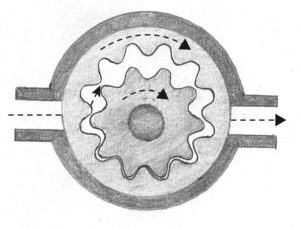Internal Gear Pump
 A type of positive displacement pump consisting of two interlocking gears of different sizes, with one rotating inside the other. The larger gear, called the rotor, is an internal gear with teeth projecting on the inside. Within the larger gear is a smaller external gear mounted off-center, designed to interlock with the rotor so the gear teeth engage at one point. A pinion and bushing attached to the pump casing holds the idler in position. A fixed crescent-shaped partition or spacer fills the void created by the off-center mounting position of the idler and acts as a seal between the inlet and outlet ports. There are three stages in an internal gear pump’s working cycle: filling, transfer, and delivery. As the gears come out of mesh on the inlet side of the pump, liquid flows into the inlet cavity and becomes trapped by the gear teeth as the gears continue to rotate against the pump casing and partition. Then, trapped fluid is transferred from the inlet, to the discharge, and around the casing. Finally, as the teeth of the gears become interlocked on the discharge side of the pump, the volume is reduced, and the fluid is forced out under pressure.
A type of positive displacement pump consisting of two interlocking gears of different sizes, with one rotating inside the other. The larger gear, called the rotor, is an internal gear with teeth projecting on the inside. Within the larger gear is a smaller external gear mounted off-center, designed to interlock with the rotor so the gear teeth engage at one point. A pinion and bushing attached to the pump casing holds the idler in position. A fixed crescent-shaped partition or spacer fills the void created by the off-center mounting position of the idler and acts as a seal between the inlet and outlet ports. There are three stages in an internal gear pump’s working cycle: filling, transfer, and delivery. As the gears come out of mesh on the inlet side of the pump, liquid flows into the inlet cavity and becomes trapped by the gear teeth as the gears continue to rotate against the pump casing and partition. Then, trapped fluid is transferred from the inlet, to the discharge, and around the casing. Finally, as the teeth of the gears become interlocked on the discharge side of the pump, the volume is reduced, and the fluid is forced out under pressure.
Internal gear pumps are non-pulsing, self-priming, and can run dry for short periods. They are also bi-rotational, meaning that the same pump can be used for loading and unloading. Internal gear pumps have only two moving parts, so they are reliable, simple to operate, and easy to maintain. The useful viscosity range of an internal gear pump is from 1 cP to more than 1,000,000 cP.
